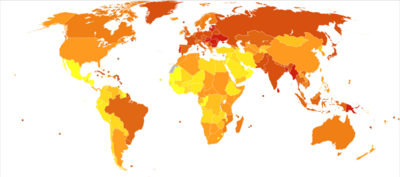Oropharyngeal tumors
Oropharyngeal tumors are becoming more common today. In men, these tumors occur up to 7 times more often than in women. Risk factors include high-risk HPV infections , smoking and alcohol. The average age is between 50-60 years. Currently, mainly HPV + lesions occur in younger patients.
Tumor types[edit | edit source]
Primary
- Benign tumors are rare (in children - hemangiomas , lymphangiomas , which may narrow the airways, hemangiomas may bleed).
- Malignant tumors
- The vast majority are differentiated squamous cell carcinomas .
- Adenocarcinoma is less common .
- Lymphomas ( Waldeyer 's circuit ,…), more rarely malignant melanoma , sarcoma appear among mesenchymal tumors .
Secondary
- Propagation of tumors from the environment (mainly from the gl. Parotis).
Symptoms[edit | edit source]
In the beginning, tumors do not have a specific symptomatology. The first symptom is usually sign of inflammation in specific area (unlike inflammation, the problems are often one-sided):
- scratching in the throat, pain, foreign body sensation, dysphagia , blood in the saliva, rhinolalia.
The first symptoms are often overlooked (due to the most commonly affected social group).
- Over time, the symptoms become more pronounced and the pain may shoot into the ear.
- Exulceration → foetor ex ore .
- Sometimes regional metastases may be the first symptom.
Diagnostics[edit | edit source]
- Palpation is of great importance .
- We take a biopsy , indicated panendoscopy to verify the scope of the process.
Clinical picture[edit | edit source]
- Tumor macroscopy :
- only as a thickening of the mucosa;
- as an exophyte of various shapes;
- have the form of an ulcer - it can grow into tonsils, the root of the tongue, the palate.
- Patients usually arrive at a late stage - at a time when the tumor has exceeded 4 cm.
- 40% already have metastases in the trigonum caroticum .
- The 3 most common locations are the tonsils, the root of the tongue and the posterior wall of the pharynx (hereinafter eg floor arches).
- Forms:
- The most common passes from the almond to the root of the tongue, to the trigonum retromolare.
- The second most common form comes from the root of the tongue and spreads along the edge of the tongue.
- Spread caudally is rare.
- Cryptogenic tumor
- A small tumor of the tonsils or root of the tongue, which is not detectable by examination methods.
Treatment[edit | edit source]
Surgery, radiotherapy and their combinations are used in the treatment of oropharyngeal tumors.
Links[edit | edit source]
References[edit | edit source]
KLOZAR, Jan, et al. Special otorhinolaryngology. 1st edition. Prague: Karolinum, 2005. 224 pp. ISBN 80-246-1125-2 .
Source[edit | edit source]
- BENEŠ, Jiří. Study materials [online]. © 2007. [feeling. 14. 12. 2011]. < http://jirben2.chytrak.cz/materialy/orl_jb.doc >.
References[edit | edit source]
- ↑ KLOZAR, Jan, et al. Special otorhinolaryngology. 1st edition. Prague: Karolinum, 2005. 224 pp. 67–72. ISBN 80-246-1125-2 .

